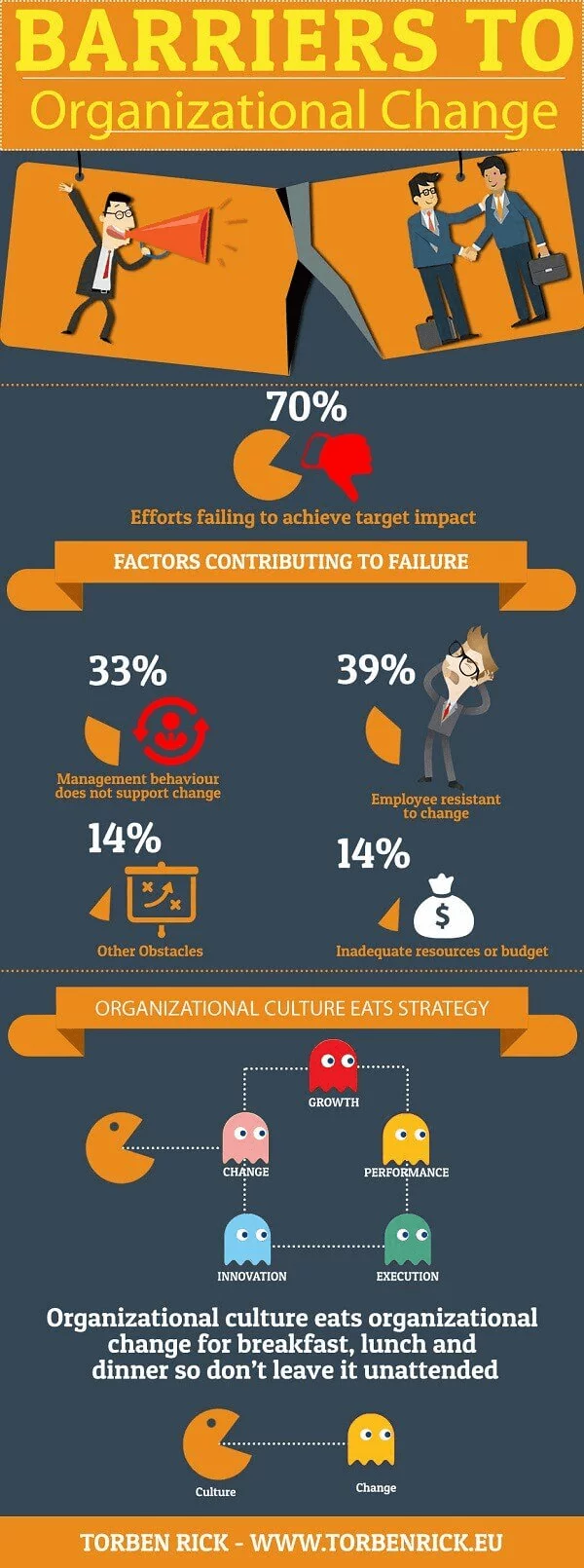
Change management is a growing discipline which continues to create job roles for professionals across the globe.
For proof of this, take a look at Prosci’s 2013 study, which states more than half of participants claimed to have clearly defined job roles within their change management strategy.
This number is expected to increase over time, since organizations are no longer relying on sharing change responsibilities.
Source image: torbenrick
It is now deserving of its own role, especially considering the regularity and complexity of modern change.
The ever-evolving business environment has driven new change requirements, so with at least one individual responsible for change, businesses are positioned to adapt more effectively.
But what exactly is the change management job description? Before we get to the principles of change managementprinciples of change management, let’s delve into some insight on the position:
Change Management Job Description
Change managers play a crucial role in company progression. Without correctly managed change, companies can struggle to transition, or to make simple changes which lead to better performance.
They’re responsible for ensuring projects remain within budget and on time. There is an increasing focus on the people side of change, where leaders must encourage staff to embrace new processes, technology, and business systems.
Breaking down the barriers to change is half the battle, and this includes influencing employee attitude. The job is embedded in changes to systems, technology, job roles, and business processes.
The change manager is responsible for new strategies, but the role extends beyond implementation. There is an increasing focus on introducing methods which minimize employee resistance, which can be a huge hurdle to overcome otherwise.
Maximize employee adoption, utilizing changes which have a profound impact on employees. This is a great opportunity to promote the benefits of change, to provide incentives which align employee duties with your company’s best interests.
Another great way to incentivize staff is with fun activities and games.
Improvements will enhance value creation, increase ROI, and ultimately drive more successful business outcomes.
Change is a people oriented role, and the success of individuals is firmly rooted in company relationships. Soft skills are important, and the change manager will also act as a mentor and change champion.
Here’s an excellent (free) white paper on what makes the difference between successful and unsuccessful change. It’s based on research with 275 leaders from multiple organisations: https://t.co/xXv4xwNV2J From @CCLdotORG pic.twitter.com/fbKB2U2ugC
— Helen Bevan (@helenbevan) October 2, 2018
A level of authenticity will help your employees go far, to give the support necessary to change.
Change Management Job Description: Roles and Responsibilities
Lead Change Activities and Apply a Structured Methodology
Creating a strategy is tough enough, but encouraging staff to support change is another battle. A good change manager will have the creativity, technical knowledge, and people skills to achieve both.
Receiving the full sponsorship of staff is a difficult process, one which involves a level of behavioral and psychological understanding. Your strategy should perfectly align with the objectives of change.
Communication
Change managers need to be proactive communicators of change. They should, if anything, over-communicate benefits, and ultimately speak change into existence.
With sponsorship from the top down, staff will be much more receptive to taking favorable action. Change managers should support the development, delivery, management, and design of communications.
Impact
Responsible for assessing the impact of change, including whether staff are truly ready to embrace new procedures. Evaluating impact also involves identifying critical stakeholders, especially those who change will affect most.
Support Training
Staff will be required to adopt new skillsets to match the new procedures introduced. Knowledge gaps can be reduced with proper training, which change managers will coordinate.
Change managers will always be involved at this stage, and be responsible for documentation, input, design and delivery. Training should involve mastering useful tools and techniques too!
3 Principles of Change Management
Understanding the principles will solidify your appreciation for change job roles. It will be a challenge if you decide to embrace change as a profession, but it will be certainly be one that keeps you on your toes.
Change is necessary if companies are to remain relevant, so here are some key principles of change management to seek your teeth into:
Culture
Taking the correct approach to change management involves understanding company culture. Change strategies should tap into values, behaviors, and assumptions, and perhaps attempt to modify cultural expectations to suit new ideals.
However, to keep everyone on the same page you should preserve the culture where possible. This will reduce the shock of new procedures, while retaining a level of familiarity to reassure staff.
Build a sense of community, perhaps by publishing stories or helping others adapt to the new status quo. Ingratiate yourself with staff, and organize events to promote togetherness. When everyone is united change is more powerful.
Patience
With change management you should be in it for the long haul. Good things come to those who wait! You should advance processes with a sense of urgency, but without putting too much pressure on staff.
Everyone will adjust at their own speed, and the more accepting you are of individual differences the greater success you’ll achieve.
It’s important you avoid overwhelming your team, because staff are more likely to become disillusioned and resistant if so. Give your employees time to accept new horizons, while offering motivation to retain their interest.
Accountability
Change leaders must set realistic expectations for their team. They must divulge accountability, clearly defining roles and duties.
It is this level of clarity which avoids confusion, empowering your team to meet objectives. When staff view themselves as a critical component within the organization’s plans, they’ll feel valued and consequently engage to meet new targets.
Staff should be rewarded when they do well, to reinforce positive behavior and keep up momentum.
WalkMe Team
WalkMe spearheaded the Digital Adoption Platform (DAP) for associations to use the maximum capacity of their advanced resources. Utilizing man-made consciousness, AI, and context-oriented direction, WalkMe adds a powerful UI layer to raise the computerized proficiency, everything being equal.




